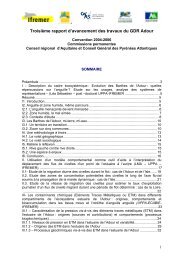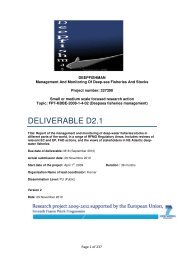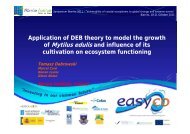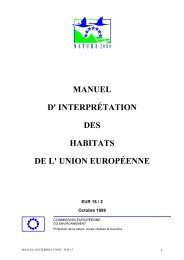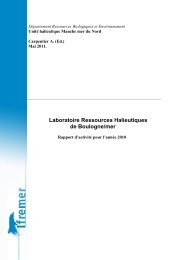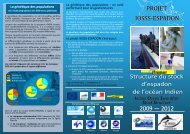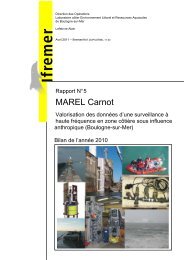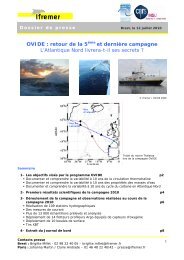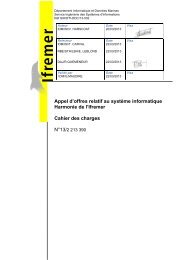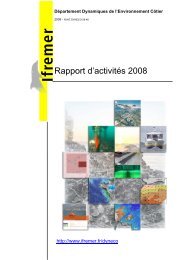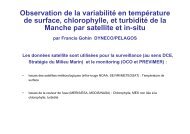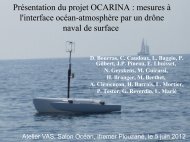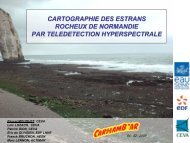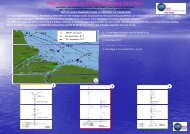Project Deliverable D50 Report on Best Practices Workshop - Ifremer
Project Deliverable D50 Report on Best Practices Workshop - Ifremer
Project Deliverable D50 Report on Best Practices Workshop - Ifremer
Create successful ePaper yourself
Turn your PDF publications into a flip-book with our unique Google optimized e-Paper software.
Names Surnames Instituti<strong>on</strong>s Emails<br />
Nicolas Nowald KDM-UNIHB-MARUM nnowald@marum.de<br />
Volker Ratmeyer KDM-UNIHB-MARUM ratmeyer@marum.de<br />
Marck Smit NIOZ msmit@nioz.nl<br />
The panel sessi<strong>on</strong> devoted to material choice included:<br />
- Objective - General overview D. Choqueuse (IFREMER)<br />
Envir<strong>on</strong>ment<br />
Material in deep sea<br />
Protecti<strong>on</strong><br />
Deep Offshore experience<br />
- NIOZ field experiences M. Smit (NIOZ)<br />
- Cathodic protecti<strong>on</strong> D.Festy (Corrosi<strong>on</strong> Institute) & D. Leflour (IFREMER)<br />
Certificati<strong>on</strong><br />
Modeling<br />
- Polymers and Composites P. Davies (IFREMER)<br />
Polymer in seawater<br />
Case studies<br />
Buoyancy Materials D. Choqueuse (IFREMER)<br />
- Cables, C<strong>on</strong>nectors, Moorings, Glass…<br />
4.4.3.4 Debriefing<br />
20 year plus Material Choice.<br />
A final text was issued; it proposes to establish guidelines.<br />
LONG-TERM DEPLOYMENT: MATERIALS FOR SUBSEA OBSERVATORIES<br />
In the definiti<strong>on</strong> of subsea observatories, from the scientific visi<strong>on</strong> to cost estimates, l<strong>on</strong>g-term<br />
sustainable operati<strong>on</strong> is a key issue and probably c<strong>on</strong>stitutes a limitati<strong>on</strong>. Any improvement in<br />
ageing of materials and comp<strong>on</strong>ents merits further study.<br />
Based <strong>on</strong> the experience gained mainly in the offshore industry [1] where materials are<br />
exposed in deep sea (up to 2000 m) for l<strong>on</strong>g time (up to 25 years), in the framework of<br />
ESONET/EMSO program guideline for the choice and selecti<strong>on</strong> of materials for l<strong>on</strong>g-term,<br />
deep-sea exposure was proposed.<br />
These guidelines, based <strong>on</strong> existing literature [2], feedback from previous experiences and the<br />
<strong>Best</strong> <strong>Practices</strong> <strong>Workshop</strong> 2 white paper of this sessi<strong>on</strong> are under preparati<strong>on</strong>. The following<br />
points are addressed:<br />
• Descripti<strong>on</strong> of the deep-sea envir<strong>on</strong>ment highlighting the influence of parameters<br />
behind acting <strong>on</strong> the degradati<strong>on</strong> process (pressure, oxygen c<strong>on</strong>centrati<strong>on</strong>,<br />
fouling, etc.)<br />
• Review of materials used in service deep sea applicati<strong>on</strong>s:<br />
Metallic material<br />
N<strong>on</strong> metallic materials<br />
• Associated protecti<strong>on</strong><br />
<str<strong>on</strong>g>Deliverable</str<strong>on</strong>g> #50 - update October 2010 40



